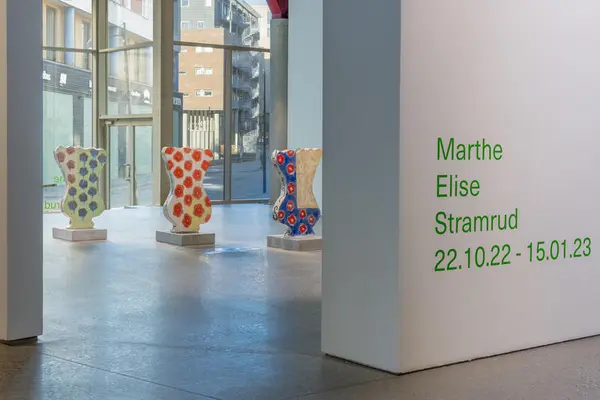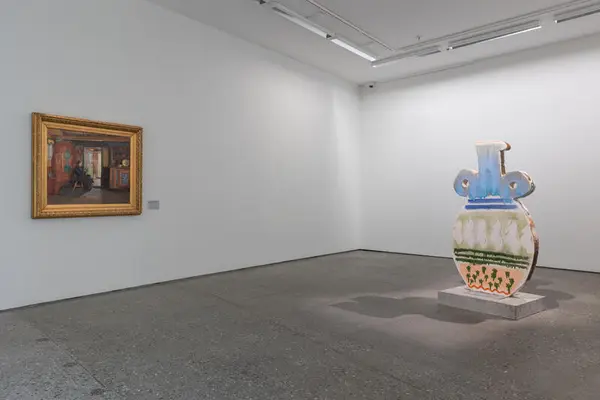Firing ceramics involves a certain loss of control: The clay is transformed from a soft and pliable material into a new form that will withstand hands, usage, and weather—not always coming out of the kiln as planned. The glaze lives a life of its own and the process which heretofore has been controlled by hand, is then left to violent temperatures in the firing process.
For Marthe Elise Stramrud (b. 1984), working with clay is a form of freedom where the game of chance and the results tell something about how the object came to be. Stramrud does not take into consideration ceramics' almost sacred set of rules, where cracks and damage mean starting over. Nor does she consider that clay of this size and thickness should not be able to be fired standing up like dominoes put into a giant kiln. When Stramrud embarked on the production of the massive sculptures that you see in this exhibition, it was with some fear that they would not come out of the kiln in one piece. “I have no plan B, it just has to go,” she said in an interview before the opening.
The glaze, which in some places has shed off the surface of the ceramic jars and now resembles melted plastic, is a reminder that these works are not about perfection, but rather exploration and process. This can be perceived as damage, but at the same time these changes in the surface and the tactility provide a clear connection with the time and craftsmanship that lies behind it.
- 1/1
The jar as a container is often interpreted as an expression of life and the feminine. Physically through its capacity to safeguard and collect food, as a transport option for other objects, but also metaphorically and symbolically as a body. The work with Stramrud's large-scale sculptures is a physical exercise, both in production and in the exhibition space, where the sculptures' proportions and scale make them human. In the main room stand seven bodies, seven sisters frozen in dance in a row— almost like backdrops. They all derive from the same basic form, but with their own peculiarities after having been forced to stand on their own two feet. They are related, they are a community and a sisterhood. They stand together at attention. A close order in calm anticipation of the next step where battle awaits. They manifest a timeline of those who have fought before and those who are still fighting.
In 2020, Marthe Elise Stramrud made a historical correction in art when she reinterpreted The Tangen Collection and included early female modernists who had been left out of history. This subsequently created ripple effects within the art history writing of Norwegian modernism. By incorporating two paintings from into the exhibition, those of Harriet Backer (1845-1932) and Sara Horneman (1863-1960) respectively, this work continues. Lines are drawn between the paintings’ waiting interiors and Stramrud's dancing jars. The motifs of the paintings resonate within the sculptures and back. Stramrud's archaic jars belong to an object category that is also linked to the home, to everyday use, and to the woman's room, all of which are reflected in the two motifs. The paintings from the collection are woven into Marthe Elise Stramrud's ceramic landscape as responses where the span between time, surface and space, two and three dimensions, and object and perception are situated for interaction. While they enhance each other's qualities, they also expand the narrative of sisterhood. The intervention is both political and feminist, alternating between historical and ongoing struggles for equality for all.
Marthe Elise Stramrud
(b. 1984) lives and works in Oslo.
She has an MFA from the Academy of Fine Arts in Oslo and a BFA from the Bergen National Academy of the Arts in 2011. Stramrud works in the frontiers of the possibilities of ceramics in bright colors with a moody and almost naïve expression. Motifs such as flowers show distinctions from the multicolored prints of pop art, objects for kitchens, and bathrooms that point to a feminist tradition focusing on the use of the intimate sphere. Some issues she worked on in the photographic medium have continued in the ceramic material with photography. A dialogue occurs between surface and depth, between two and three dimensions, between image and object of use.
Stramrud has taken part in several solo and group exhibitions and carried out two major decoration projects. Her work has been purchased for several private and public collections, including the National Museum, KODE Kunstmuseene i Bergen, SKMU, Sørlandet's Kunstmuseum, KORO Kunst i Offentlig Rom, Oslo municipality's art collection and Kunst på arbeidsplassen. Stramrud has been awarded several scholarships and awards for her work. She has recently published the critically acclaimed book "Ceramic Factual Enlightenment" (2021), which contains a reinterpretation of the Tangen collection limitations, presenting an alternative collection of 76 female artists with factual insights printed in ceramics.







